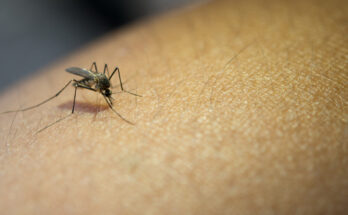
Swimmer’s ear—or in medical terms otitis externa—is an infection of the ear canal caused by a build-up of bacteria in the external ear from exposure to water. It is often mistaken for otitis media (or an inner ear infection) where the pathogen is trapped behind the ear drum. But the conditions are different and treated differently. In the case of otitis externa, antibiotic treatment must be applied directly to the diseased surfaces in prescribed droplets, while otitis media is treated by taking antibiotics orally.
Otitis externa presents with swelling and redness of the external auditory canal which can become quite painful. The outer ear can swell such that the entire canal opening might close off and the ability to hear is significantly reduced. External ear infections are also associated with a purulent discharge, which can be white to yellow in color and is relatively thick. This discharge is often referred to as otorrhea.
Fevers can be associated with this outer ear infection, but they rarely increase above 101°F. The most common bacteria found in external ear infections are Staphylococcus aureus and Pseudomonas aeruginosa. Swimmer’s ear can be distinguished by a simple triad of (1) recent swimming or submersion in water (especially in lakes or the ocean), (2) pain upon touching the external ear or the tragus which is the small flap of tissue that sticks out in front of the ear canal, and (3) possibly ear discharge and/or auditory canal swelling. It is more common in summer months and the infected person will have been exposed to water in the past week. It is typically an isolated condition.
Otitis media on the other hand is a collection of infected fluid or pus behind the tympanic membrane. This condition is often associated with another illness such as pneumonia, pharyngitis, or an upper respiratory infection. Children with otitis media will become more restless during the night, while those with otitis externa will more uncomfortable upon chewing or eating during the day or when they lay on the infected ear. The hearing loss in otitis media can get up to 30 decibels (dB). It is more common in the winter months and is not associated with swimming.
These two conditions can be easily confused in the earlier stages when the ear canal is not yet swollen and the only signs are pain and redness.
Swimmer’s ear prevention does include avoidance of water, but in the summer months, avoiding water is not a realistic option. Instead, after getting wet, it is strongly advised for swimmers to immediately dry their ears. The excess moisture increases the pH in the ear canal by removing the natural protection of the ear’s waxy secretions. The protective pH of the ear canal is typically 4.5 compared to the internal body pH of 7.4. When the pH becomes more basic, it creates an opportunity for the bacteria to grow and results in an outer ear infection.
Mixing one-part distilled vinegar with one-part rubbing alcohol and applying 3 drops to each ear after swimming can reduce the incidence of otitis externa. Another prevention technique is to apply a blowdryer on a gentle but cool setting to the ear to dry out the auditory canal after submersion in water.
Treatment typically is antibiotic ear drops unless the ear canal is swollen shut. If the canal is closed then a healthcare practitioner may have to insert a wick into the swollen opening soaked in antibiotics. The medication needs to be in direct contact with the infected surfaces in the ear. When a person applies the antibiotics to the ear, it is recommended that they press the tragus a few times after pouring in the ear drops. This action mixes the medication around more in the ear and increases the likelihood of direct contact with all surfaces.
It is recommended that a person experiencing these ear symptoms should contact their primary care provider as soon as possible begin to discuss their own individual treatment regimen. Swimmer’s ear is easy to treat in the early stages, but becomes more difficult to manage if it worsens.
(Bio: Dr. Zender is an occupational and environmental physician with a background in medical journal writing, industrial accident mitigation, and environmental and chemical exposures.)



